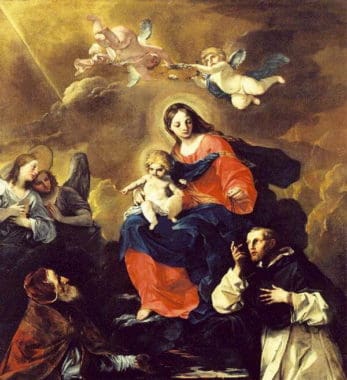Which Rosary Should I Pray?
Dear Father John, In reading of the various spiritual traditions within the Church: i.e., Carmelite, Servite, Franciscan, etc., etc., it seems to me many of them have their own special rosaries that they pray. Would you kindly please explain these? And, when someone says “Pray the Rosary” which one do they mean? Is it OK, for example, to pray a Carmelite rosary instead of your standard every day garden variety rosary? Does that suffice? Also, what if a priest assigns, as a penance in the confessional, the penance of praying the rosary, which one are we supposed to pray? Thank you so much.
The Rosary is a form of prayer that combines meditative reflection on the mysteries (by this we mean the significant “events”) of the life of Christ and Mary with the repetition of vocal prayers (Our Father, Hail Mary, etc.). Through the centuries, the Catholic faithful, under the inspiration of the Holy Spirit and the guidance of the Church, have made different choices regarding which mysteries to reflect on and which vocal prayers to use in accompanying those reflections. This is why different spiritual families within the Church (Carmelite, Franciscan, etc.) sometimes have different ways of praying the Rosary – they may vary which mysteries are meditated on and which vocal prayers are repeated. The history of this development is interesting and varied. If you want to learn more about it, you can find a good article here: https://www.ewtn.com/library/answers/rosaryhs.htm. I have also recorded a video retreat guide on the Rosary called “River of Wisdom”, which you can view or download for free here: http://rcspirituality.org/the-river-of-wisdom-a-retreat-guide-on-the-rosary/.
The Most Common Form
Since the late Middle Ages, one form of the Rosary has become the most common. This consists of one “decade” (one Our Father, ten Hail Marys, one Glory Be – the “O My Jesus, forgive us our sins…” prayer was added after the apparitions of Our Lady in Fatima in 1917) being prayed for five mysteries. The five Joyful Mysteries are prayed on Mondays and Saturdays, the five Sorrowful Mysteries on Tuesdays and Fridays, the five Glorious Mysteries on Wednesdays and Sundays, and the five Luminous Mysteries (added recently by St. John Paul II) on Thursdays. The most common way to introduce the Mysteries is by praying the Apostle’s Creed, one Our Father, three Hail Marys, and a Glory Be. The most common way to finish the Rosary is to pray for the needs and intentions of the Pope, using an Our Father, three Hail Mary’s, and a Glory Be. But as you mentioned in your question, and as I mentioned above, there are variations on all of these aspects.
It’s worth noting that the Rosary as a form of devotional prayer has been encouraged by modern popes more than any other devotional form of prayer. Almost all the popes of the twentieth century wrote encyclicals praising and explaining the Rosary, and encouraging all of the Catholic faithful to pray it frequently, whether alone or together as families and parish communities. The most recent papal letter on the Rosary was St. John Paul II’s Apostolic Letter from 2002, Rosarium Virginis Mariae (Rosary of the Virgin Mary). If you haven’t read it, I encourage you to do so – it is a beautiful way to discover the treasures of this ancient form of Christian prayer by clicking here.
Personalized Penance
If a priest assigns the Rosary as a penance, you should pray whichever Rosary you usually pray. If you don’t usually pray the Rosary, then maybe just pray the most common form, as described above. Here is a more thorough explanation of how to do that: http://www.usccb.org/prayer-and-worship/prayers-and-devotions/rosaries/how-to-pray-the-rosary.cfm. And here is an App for praying the Rosary: http://www.familyrosary.org/TheRosary/MobileRosary.aspx.
I hope my answer helps, at least a little bit. God bless you!! Fr. John
+
Art for this post on which rosary should be prayed: Modified detail of Virgin and Child with Angels and Saints [with Rosary], Felice Torelli, 1700s, PD-US author’s term of life plus 100 years or less, Wikimedia Commons.




